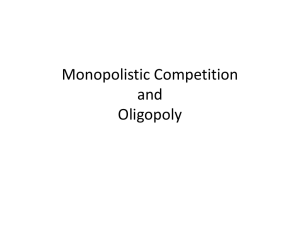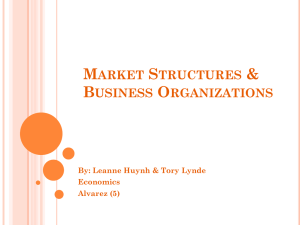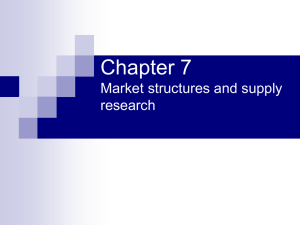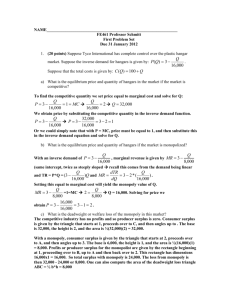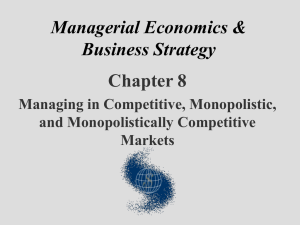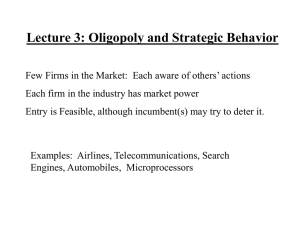Answers to Homework 5
advertisement
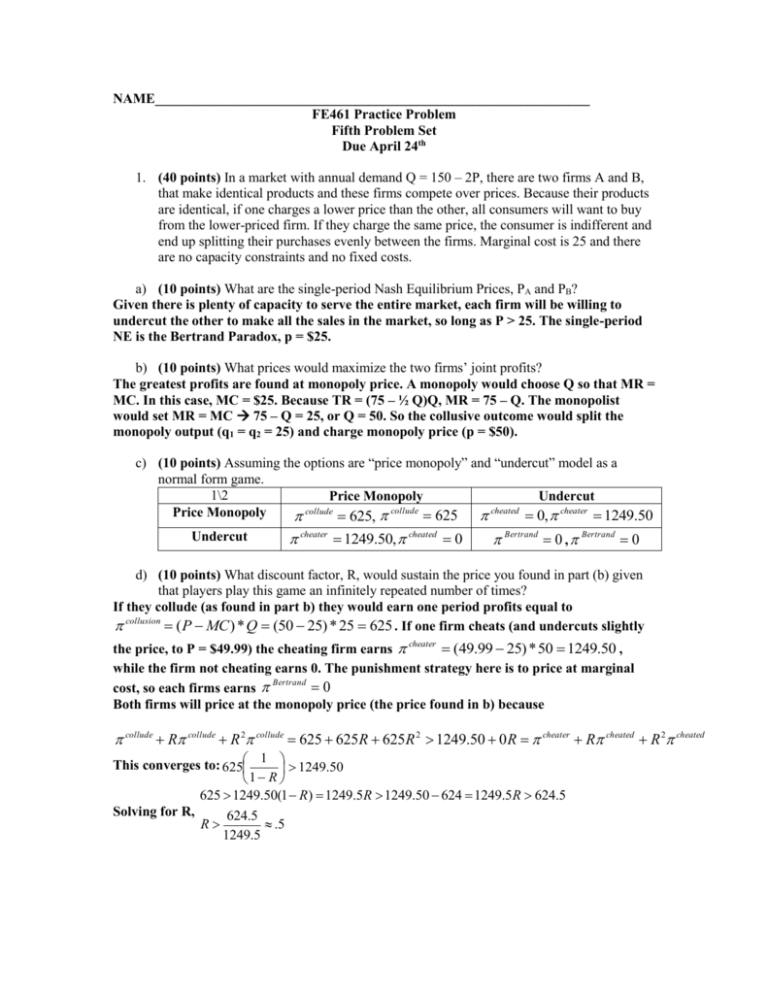
NAME_______________________________________________________________
FE461 Practice Problem
Fifth Problem Set
Due April 24th
1. (40 points) In a market with annual demand Q = 150 – 2P, there are two firms A and B,
that make identical products and these firms compete over prices. Because their products
are identical, if one charges a lower price than the other, all consumers will want to buy
from the lower-priced firm. If they charge the same price, the consumer is indifferent and
end up splitting their purchases evenly between the firms. Marginal cost is 25 and there
are no capacity constraints and no fixed costs.
a) (10 points) What are the single-period Nash Equilibrium Prices, PA and PB?
Given there is plenty of capacity to serve the entire market, each firm will be willing to
undercut the other to make all the sales in the market, so long as P > 25. The single-period
NE is the Bertrand Paradox, p = $25.
b) (10 points) What prices would maximize the two firms’ joint profits?
The greatest profits are found at monopoly price. A monopoly would choose Q so that MR =
MC. In this case, MC = $25. Because TR = (75 – ½ Q)Q, MR = 75 – Q. The monopolist
would set MR = MC 75 – Q = 25, or Q = 50. So the collusive outcome would split the
monopoly output (q1 = q2 = 25) and charge monopoly price (p = $50).
c) (10 points) Assuming the options are “price monopoly” and “undercut” model as a
normal form game.
1\2
Price Monopoly
Undercut
cheated
collude
collude
Price Monopoly
0, cheater 1249.50
625
625,
Undercut
cheater 1249.50, cheated 0
Bertrand 0 , Bertrand 0
d) (10 points) What discount factor, R, would sustain the price you found in part (b) given
that players play this game an infinitely repeated number of times?
If they collude (as found in part b) they would earn one period profits equal to
collusion ( P MC ) * Q (50 25) * 25 625 . If one firm cheats (and undercuts slightly
the price, to P = $49.99) the cheating firm earns cheater (49.99 25) * 50 1249.50 ,
while the firm not cheating earns 0. The punishment strategy here is to price at marginal
Bertrand
0
cost, so each firms earns
Both firms will price at the monopoly price (the price found in b) because
collude R collude R 2 collude 625 625R 625R 2 1249.50 0 R cheater R cheated R 2 cheated
This converges to: 625 1 1249.50
1 R
625 1249.50(1 R) 1249.5R 1249.50 624 1249.5R 624.5
Solving for R,
624.5
R
.5
1249.5
2. (60 points) Suppose that two firms compete in quantities in a market in which demand is
described by : P = 260 – 2Q. Each firms incurs no fixed cost buy has a marginal cost of
20.
a) (10 points) If the game is played once, what is the profit for each firm in the equilibrium?
MR2 260 2Q1 4Q2 20 MC2
1
Q2 60 Q1
2
By symmetry and simultaneously solving:
1
Q1 60 Q2
2
1
1
1
Q2 60 (60 Q2 ) 30 Q2
2
2
4
Q1 Q2 40 P 260 2(80) 100
1Cournot 2Cournot (100 20)( 40) 3200
b) (10 points) If the firms decide to collude, what is the profit for each firm?
Q Monopoly 60 P Monopoly 260 2(60) 140
Therefore, profit of each firm in a cartel is
1Cartel 2Cartel (140 20)( 30) 3600
c) (10 points) If one firm chooses to cheat on the collusive agreement, while the other firm
produces the agreed upon collusive quantity, what quantity will the firm cheating on the
agreement produce? What is that firm’s profit?
Without loss of generality, suppose Firm 2 cheats, but Firm 1 maintains its cartel quantity of 30.
Then, the optimal choice for Firm 2 can be found from its best response function.
Q2Cheating 60
1
(30) 45
2
Therefore, the market price is 260 – 2 (30+45) = 110. As a result, the profit of the cheating firm
is: 2Cheating (110 20)( 45) 4050
d) (10 points) If one firm chooses to cheat on the collusive agreement, while the other firm
produces the agreed upon collusive quantity, what is the profit for the firm that produces
the agreed upon collusive quantity if the other the firm cheats on the agreement?
2Colluding (110 20)(30) 2700
e) (10 points) Assuming the options are “colllude” and “undercut” model as a normal form
game. (You can assume the outcome {undercut, undercut} leads to the Cournot NE.)
Firm 1
Collude
undercut
Firm 2
Collude
3600, 3600
4050, 2700
undercut
2700, 4050
3200, 3200
e) (10 points) What discount factor, R, would sustain the price you found in part (b) given
that players play this game an infinitely repeated number of times?
Value collude 3600 3600 R 3600 R 2 ... 4050 3200 R 3200 R 2 ... Value cheater and punish
This converges to: 3600 1 4050 3200 R 1
1 R
1 R
3600 4050(1 R) 3200 R 850 R 450
Solving for R,
450
R
.53
850
